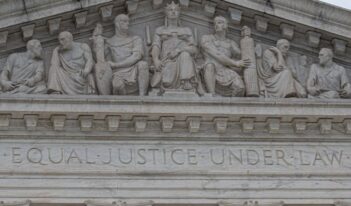
A Supreme Court decision from last term allows states to subsidize student attendance at religious schools.
Does excluding religious schools from a state-sponsored scholarship program amount to unconstitutional discrimination? According to at least five members of the U.S. Supreme Court, the answer is “yes.”
The Supreme Court addressed this question this past summer in a case involving a Montana program that provided tax credits for people who donated to student scholarship organizations that would use donations to help families pay for private school tuition. Under the scholarship fund’s rules, recipients could use this funding at any “qualified education provider.”
The Montana Constitution, however, contains a “no-aid” provision that prohibits the state from providing financial aid to religious schools. Consistent with this provision, the Montana Department of Revenue issued a tax rule excluding religious schools from participating in the scholarship program. As a result, families could not use their scholarships at religious institutions.
Three mothers challenged this rule, hoping to use scholarships to send their children to a Christian school that otherwise satisfied the statutory criteria for a “qualified education provider.” The mothers obtained a court order prohibiting the exclusionary tax rule from going into effect, allowing more than ninety students to receive scholarships to attend religious schools.
The Montana Supreme Court, however, reversed course. The state high court held that the scholarship program violated the state constitution’s no-aid provision by “using tax credits to ‘subsidize tuition payments’” at private religious schools. Accordingly, the court invalidated the entire scholarship program. The court also determined that the Montana Department of Revenue exceeded its authority by limiting which schools were “qualified education providers.” The rule excluding religious institutions impermissibly “transformed” an unconstitutional program into a constitutional one—a transformation that only the state legislature, not a state agency, could make.
The mothers then appealed to the U.S. Supreme Court.
In their case, Espinoza v. Montana Department of Revenue, the Supreme Court first noted that the First Amendment’s Establishment Clause, which prohibits state actors from making laws “respecting an establishment of religion,” does not bar the enactment of a scholarship program like Montana’s. The Establishment Clause, the Court explained, “is not offended when religious observers and organizations benefit from neutral government programs.”
The question in Espinoza, as the majority opinion explained, was about the Montana Revenue Department’s rule: Did the First Amendment’s Free Exercise Clause prohibit Montana from excluding religious schools from participating in the scholarship program?
A decision from 2016, Trinity Lutheran Church v. Comer, set the stage for Espinoza. In Trinity Lutheran, a generally available Missouri program reimbursed schools that replaced rough, gravel playground surfaces with recycled rubber tires. The State of Missouri denied a religious daycare center participation in this program, reasoning that state agencies were categorically prohibited from providing financial assistance directly to churches. The Supreme Court concluded that in doing so, the state had forced the daycare center to choose between “being a church” or “receiving a government benefit.” Missouri had “expressly discriminated against otherwise eligible recipients by disqualifying them from a public benefit solely because of their religious character” in violation of the Free Exercise Clause.
In Espinoza, Montana had argued that this application of the no-aid provision did not constitute discrimination based on religious identity. Rather, it merely prohibited religious uses of state funding—specifically, the use of state funds to provide a religious education and classroom environment. As a result, constraining the state-sponsored scholarship program so as not to facilitate religious education differed from Trinity Lutheran, where playground resurfacing was completely isolated from the daycare’s religious mission.
The Court rejected that distinction, holding that Montana’s application of the no-aid provision was status-based discrimination.
Writing for the majority in both cases, Chief Justice John Roberts drew a parallel between the facts in Trinity Lutheran and those in Espinoza. He noted that Montana’s no-aid provision “singles out schools based on their religious character” and constitutes discrimination based on religious identity or status. Just as in Trinity Lutheran, where Missouri denied public benefits to a daycare due to its religious affiliation, in Espinoza, Montana blocked otherwise qualified schools from participating in the scholarship program because of their religious affiliation.
Status-based religious discrimination is only permissible when government action is narrowly tailored to “advance interests of the highest order.” The Court ultimately held that Montana did not have a compelling reason for denying religious schools participation in the scholarship program.
Other justices weighed in on the distinction between discrimination based on religious status and religious activity, uses, or conduct. Justice Neil Gorsuch, who joined the Court’s majority, wrote separately to express skepticism about the status-activity distinction, noting that “the state’s discrimination focused on what religious parents and schools do—teach religion.” But he ultimately concluded that “whether the Montana Constitution is better described as discriminating against religious status or use makes no difference: It is a violation of the right to free exercise either way unless the State can show its law serves some compelling and narrowly tailored governmental interest.”
Justice Stephen Breyer, on the other hand, took issue with the majority’s reliance on Trinity Lutheran, arguing instead that the Court should look to its previous decision in Locke v. Davey. In Locke, the Court upheld a scholarship program that funded students on the condition that they not pursue degrees that were “designed to induce religious belief.” Excluding “devotional studies” from tax-payer funded scholarship programs was not a Free Exercise violation because it did not “require anyone to choose between their faith and a ‘government benefit.’” Justice Breyer concluded that, as with Locke, Espinoza was not a case of status-based discrimination—rather, the application of Montana’s no-aid provision simply prevented families “from using taxpayer-supported scholarships” to facilitate religious education.
Some commentators have critiqued the distinction between status and use discrimination as “unstable.” Despite this critique, it appears that, after Espinoza, state-funded school choice programs cannot constitutionally exclude religious institutions from obtaining generally available benefits.
Espinoza is one of many recent cases in which members of the Court have emphasized the importance of religious liberty. With a new justice on the Court, and other religious freedom cases on the Court’s current docket, the Court’s recent efforts to prioritize the protection of religious liberty may continue in the coming year.



